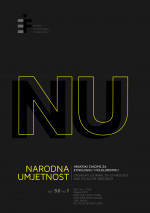DISPLAYING SOCIETY: CROATIAN MUSEUMS AND GALLERIES BETWEEN PEDAGOGY AND PERFORMATIVITY
DISPLAYING SOCIETY: CROATIAN MUSEUMS AND GALLERIES BETWEEN PEDAGOGY AND PERFORMATIVITY
Author(s): Ewa Wróblewska-TrochimiukSubject(s): Education, Fine Arts / Performing Arts, Museology & Heritage Studies, Recent History (1900 till today)
Published by: Institut za etnologiju i folkloristiku
Keywords: performative museum; pedagogical museum; Croatia; art;
Summary/Abstract: The aim of the paper is to present selected Croatian museum and gallery exhibitions in the light of the phenomenon of museum transformation from the pedagogical into the performative model. Contemporary museums and art galleries initiate new forms of activity. In the old pedagogical model (dominant in the nineteenth and early twentieth centuries) art institutions pretended to be neutral and specified education as their main task. This model has been replaced by a performative one which emphasizes cultural relativism, and focuses on the sensory aspect of perception, highlighting the role of the embodied and the sensual. This paper focuses on examples of three Croatian exhibitions: “Socijalizam i modernost. Umjetnost, kultura, politika 1950–1974” (Socialism and modernity. Art, culture, politics 1950–1974) (2011–2012), “Kome treba poduzeće? Slučaj Borovo 1988–1991” (Who needs a company? The case of Borovo 1988–1991) (2016), “Kako živi narod – izvještaj o pasivnosti” (How the people live – a report on passivity) (2016). I intend to show that in spite of widespread opinions to the contrary, museums have not moved away from their original pedagogical task. They still shape reception and they are still deeply interested in power. However, they do this by using modern performative tools – by creating a neural, haptic and multi-sensory relation between the recipient and the object.
Journal: Narodna umjetnost - Hrvatski časopis za etnologiju i folkloristiku
- Issue Year: 56/2019
- Issue No: 1
- Page Range: 41-54
- Page Count: 14
- Language: English

